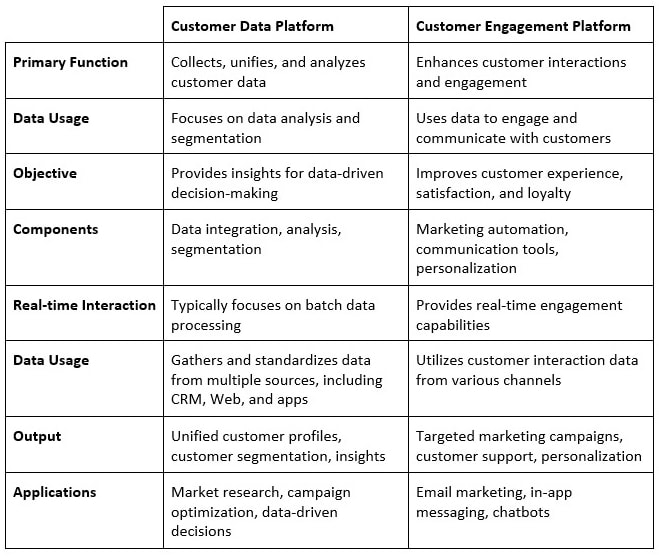Customer engagement platforms (CEPs) and customer data platforms (CDPs) are sometimes confused.
The confusion arises from the overlapping nature of their objectives, wherein data plays a critical role in personalized engagement strategies; but their respective primary functions differ.
This article will highlight the unique roles of CEPs and CDPs, real-world use cases, and ways they can be harnessed to overcome the challenges of customer-centric strategies.
Customer Data Platform: Building a Unified Customer Profile
A CDP is a centralized software system that collects, integrates, and analyzes customer data from various sources, such as websites, apps, and transactions. It creates a comprehensive customer profile, allowing businesses to better understand their customers.
A customer data platform helps businesses to achieve the following aims:
- Unified customer view: CDPs consolidate data from various sources, creating a comprehensive customer profile.
- Data-driven decision-making: CDPs empower data-based strategies and operational efficiency.
- Personalized marketing: Businesses can tailor campaigns for more effective customer engagement.
- Enhanced customer experiences: Timely and relevant content improves overall customer satisfaction and loyalty.
- Data privacy compliance: Secure handling of data ensures adherence to privacy regulations.
A CDP operates through a systematic algorithm. It begins by gathering data from diverse sources, including websites and apps. That data is then integrated and organized into a unified customer profile. Advanced algorithms analyze the information, extracting valuable insights and patterns. Utilizing those insights, the CDP allows businesses to tailor marketing and communication strategies for individual customers, facilitating personalization. Customer profiles are continuously updated to maintain accuracy. CDPs also often integrate with other marketing tools through APIs, enabling seamless execution of personalized campaigns.
To sum up, the primary task of a CDP is to collect, integrate, and analyze customer data from various sources to create unified customer profiles for personalized, data-driven marketing and improved customer experiences.
Customer Engagement Platform: Interacting with Customers Smartly
A CEP is a system designed to facilitate and manage customer interactions across multiple channels, such as websites, mobile apps, social media, email, and support services. It centralizes customer touchpoints, allowing businesses to effectively communicate with and engage their customers.
Unlike a CDP, which primarily focuses on data collection and analysis, a CEP emphasizes customer interaction and relationship management, providing tools for marketing communication, customer support, and customer journey optimization. It helps businesses enhance customer experiences to drive engagement, loyalty, and satisfaction.
A CEP assists businesses in realizing the following objectives:
- Improved customer satisfaction: By delivering personalized and timely interactions, it enhances overall customer experiences.
- Enhanced customer loyalty: Engaging customers across multiple touchpoints fosters stronger, long-term relationships.
- Increased customer retention: Targeted communications reduce churn rates and boost customer loyalty.
- Higher conversion rates: Tailored content and engagement strategies lead to more successful marketing campaigns.
- Efficient multichannel interaction: It streamlines communication and support processes, saving time and resources.
- Brand advocacy: Satisfied customers are more likely to become brand advocates, driving organic growth and positive word-of-mouth.
A CEP's work begins by collecting and analyzing customer interaction data from various sources, such websites, social media, and email interactions, to understand customer preferences and behaviors. Next, the platform creates tailored engagement strategies, including personalized content, offers, notifications, and more. It then tracks and evaluates the effectiveness of these strategies, making real-time adjustments.
The ultimate goal of a customer engagement software is to facilitate and optimize interactions between businesses and customers across various channels, continuously improving customer experiences to drive engagement and satisfaction.
CDP vs. CEP: Comparison Table
These two distinct types of platforms serve different but complementary roles in customer-centric business operations.
They often work in tandem: CDP provides the necessary data insights, enabling CEP to create and execute personalized, targeted customer engagement strategies, resulting in improved customer satisfaction and business outcomes.
The following comparative table covers their primary functions, objectives, data usage, components, and more, helping to clarify the specific focus and contributions of each platform in the customer engagement and data management landscape.

To get a more practical glimpse of how CDP and CEP differ yet complement each other, let's consider three use-cases.
CDP & CEP: Vertical-Specific Use Cases
Use-Case 1: E-Commerce Business
Customer engagement platform. Imagine an online electronics retailer. By implementing a CEP, it can collect data on customer behavior, including website visits and purchase history. Using that data, the CEP sends personalized product recommendations, discounts, and relevant content through email marketing and targeted ads. Customers receive tailored shopping experiences, making it more likely for them to return, increasing the likelihood of repeat purchases, and fostering brand loyalty. That process enhances customer engagement and satisfaction.
Customer data platform. In the same e-commerce business, a CDP helps unify and manage customer data from various sources, such as website interactions, mobile app use, and social media engagement. That integrated data creates comprehensive customer profiles, allowing the retailer to better understand customer preferences and behavior. With the insights provided by the CDP, the company can refine its product recommendations, personalize marketing strategies, and optimize inventory management. Doing so not only boosts customer engagement but also reduces marketing costs and inventory waste, leading to higher profits and customer satisfaction.
Use-Case 2: Subscription-Based Business
Customer engagement platform. Consider a subscription-based streaming service. By tracking subscriber behavior, a CEP can suggest personalized content, create tailored playlists, and send reminders for upcoming shows or movies. The CEP sends targeted email notifications and in-app messages to re-engage dormant subscribers with exclusive offers. It also handles customer support through chatbots, ensuring swift issue resolution. Those personalized interactions lead to increased subscriber engagement, longer subscription periods, and improved user satisfaction.
Customer data platform. In the same streaming service, a CDP plays an integral role. It aggregates customer data from multiple sources, such as app use, website visits, and subscriber preferences. Analyzing that data, it segments users into categories based on their viewing habits, helping marketing teams identify target audiences more effectively. It also assists in optimizing content licensing agreements, reducing operational costs, and ensuring content recommendations align with viewer preferences. The CDP's insights enable the company to improve its content library, promotional strategies, and customer retention initiatives.
Use-Case 3: Fintech Company
Customer engagement platform. In a fintech business offering digital banking services, a CEP uses real-time transaction data to send personalized alerts, updates, and security notifications to users' mobile apps. The CEP also provides an interactive chatbot for immediate customer support and financial advice. By tailoring communications and in-app messages, it fosters user engagement, increasing customer satisfaction and trust in the platform. Moreover, the CEP can send notifications about personalized investment opportunities, financial tips, and exclusive offers, improving cross-selling and upselling.
Customer data platform. For the same fintech business, a CDP plays a pivotal role in managing customer data securely. It aggregates and centralizes data from various sources, including transaction histories, account details, and user behavior. By analyzing that data, the CDP can segment users based on their financial goals, risk tolerance, and transaction patterns, enabling more effective marketing campaigns. It also helps the business comply with data privacy regulations and improves fraud detection by identifying unusual transaction patterns.
Bottom Line
Customer engagement platforms focus on enhancing customer interactions and experiences through personalized marketing, real-time communication, and support tools. They have the potential to improve customer satisfaction, loyalty, and cross-selling opportunities, making them vital for businesses looking to foster customer engagement.
On the other hand, customer data platforms primarily collect, unify, and analyze customer data, offering valuable insights for data-driven decisions and more effective marketing strategies. They have the potential to streamline operations, optimize campaigns, and ensure data privacy compliance, making them essential for data-centric business growth.
The synergy between CEP and CDP enables accurate personalization of marketing strategies and leads to improved and long-lasting engagement, resulting in higher profitability for businesses across domains.
More Resources on CDPs and CEPs
CDPs, DMPs, CRMs... Oh My! Which Data Solution Is Right for You? (A Guide for Marketers)
Is Your Martech Vendor Serving You Unpalatable Alphabet Soup?




